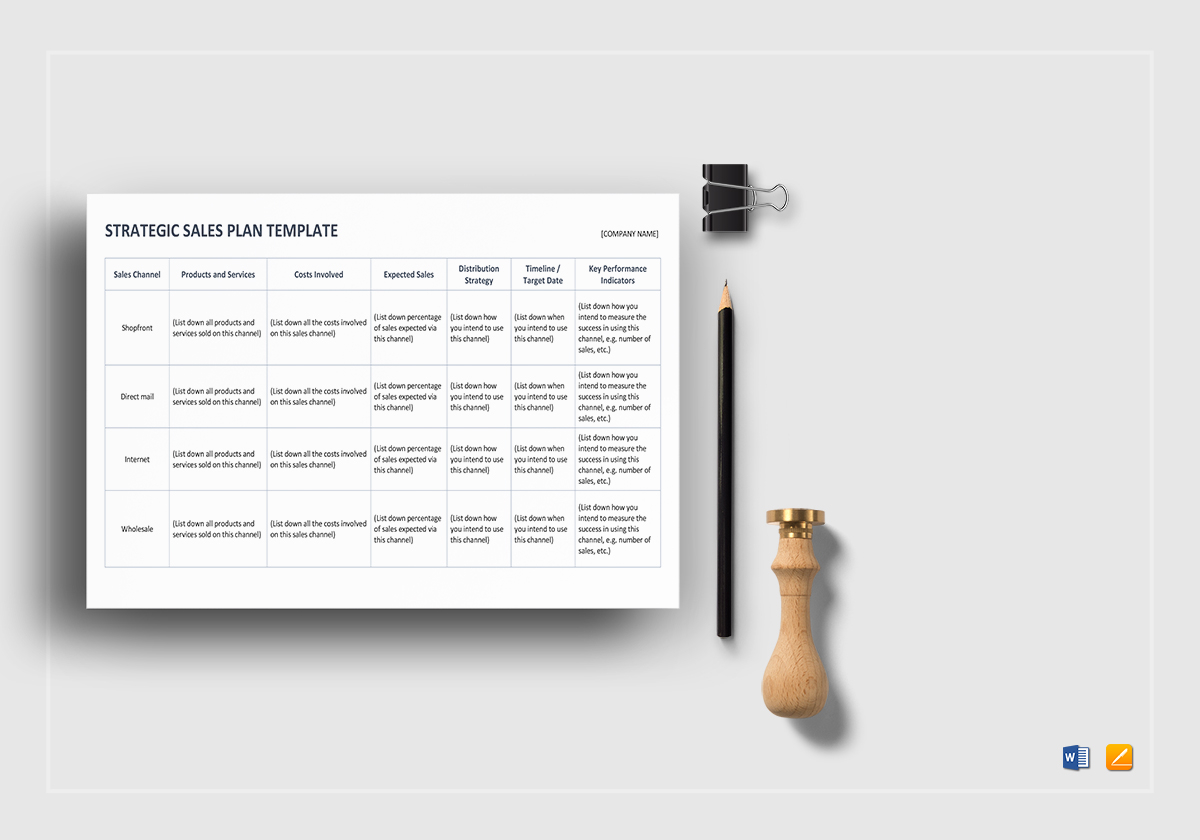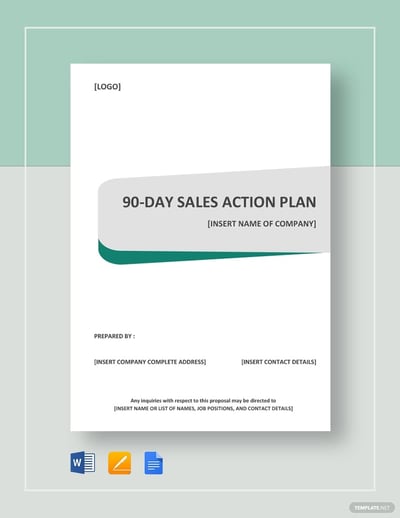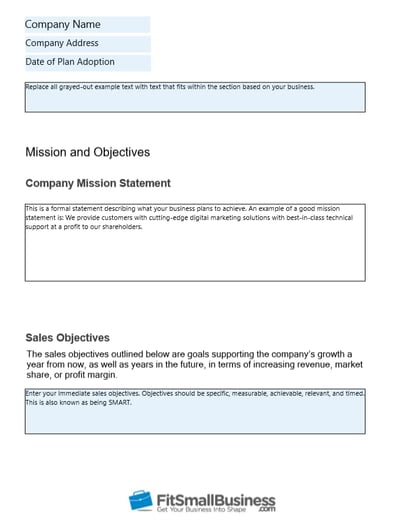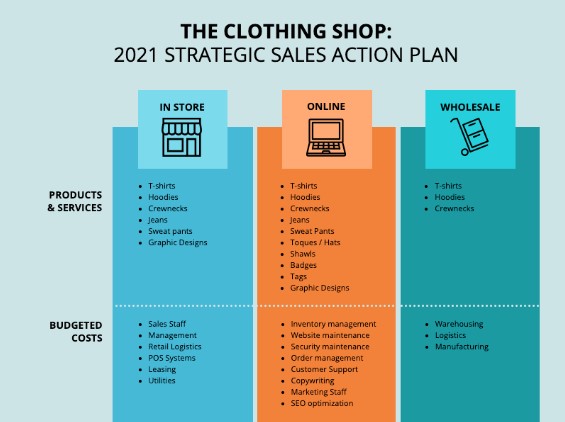Sales planning is a crucial process in which businesses define their sales objectives, strategies, and tactics to achieve desired outcomes.
It involves setting clear goals, identifying target markets, analyzing customer needs, and developing comprehensive plans to guide the sales team’s activities.
Sales planning ensures that sales efforts are aligned with the overall business strategy and helps organizations optimize revenue generation and profitability.
The goal of this process is to set up realistic expectations that align with business objectives and help you make better decisions about how much money you should invest in marketing, hiring, etc.
To create an effective sales plan, it needs to be broken down into smaller pieces so that everyone can understand what they need to do every day (and why).
In this blog post, we will discuss what sales planning is, the best practices to develop a successful sales planning process, and simple templates (downloadable) for a killer sales strategy.
Table of Contents
What Is Sales Planning?
Primarily, sales planning consists of several key components. Number one, it requires a thorough understanding of market dynamics.
This mainly comprises identification of your target customers, understanding their needs and preferences, and receiving actionable insights about the competition’s strengths and weaknesses.
By determining the most optimal sales channels, creating smart promotional campaigns, and employing intelligent sales processes and methodologies.
Sales strategies need to always be customer-centric, and should address the customers’ pain points to enable maximum sales effectiveness.
Moreover, sales planning also involves creating a sales forecast that can project the sales performance going forward. This can be achieved by a careful analysis of market trends, historical sales data, customer behavior, and other necessary factors to predict future sales volumes.
A well-researched sales forecast allows businesses to distribute resources optimally, plan the levels of inventory, and expect fluctuations of the market.
Monitoring and measurement play a crucial role in sales planning. Key performance indicators (KPIs) are established to track progress towards sales objectives.
These KPIs may include revenue targets, sales conversion rates, customer acquisition costs, and customer satisfaction levels.
Regular analysis of these metrics enables businesses to assess the effectiveness of their sales strategies, identify areas for improvement, and make necessary adjustments to the sales plan.
Sales managers often start this process by creating a list of potential customers called accounts. They then prioritize those accounts based on factors such as size, growth rate, and buying power, so they can focus on selling only to the most likely prospects first instead of wasting time pursuing unlikely buyers who won’t buy anyway.
After salespeople have identified their accounts, they determine which products or services to sell.
Then they create a sales plan that maps out the steps needed to turn prospects into customers and keep them satisfied so they will remain loyal in the future.
Sales planning can be an ongoing process throughout the year, where sales reps are constantly reevaluating every account’s status on a regular basis by tracking new leads or new opportunities with existing ones. This can be done each month or each quarter.
It allows sales managers to better understand how their team is performing against quotas for different types of customer business segments at specific times of the year based on seasonality factors associated with product lines being sold.
To put it simply, sales planning is about ensuring your company meets its goals through effective strategic efforts.
So, How Does Sales Planning Differ From a Sales Plan?
A sales plan is like a business plan that specifies sales strategy inclusive of sales goals, tactics, challenges, target market, and steps you will take to execute the plan.
It specifies short and long-term planning for the entire sales goals. It also lists out the incentives associated with each target goal to motivate salespeople.
On the other hand, sales planning is an ongoing process that is carried out throughout the year and adjusted according to market conditions. It defines the steps in a sales plan that can help your team reach their sales targets and enjoy their rewards.
It’s crucial to shift to planning once the sales plan is ready especially when your sales team starts to grow.
A sales leader should be able to address changes as they happen.
In essence, sales planning is a set of (modifiable) guidelines created to help companies achieve their goals.
Read aslo: Sales Analysis: Learn To Zoom In & Master the Pipeline
What Elements Make Up a Sales Planning Template?
A sales plan might differ depending on your exact requirements. But a typical sales planning process template includes the following:
Executive Summary
It states your company’s vision and mission. For instance, your ultimate sales goal would be to reach X million in valuation by Q4 2021.
It includes your company’s background story and what you do and what you wish to achieve.
Revenue Goals
How much revenue does your team aim to bring at the end of a period?
Always keep an achievable revenue target so that your sales team can actually reach that goal.
Industry & Market Overview
Sales planning templates also need to include competitor analysis, industry trend reports, market research, and other information that will give you an overview of your market condition.

Target Customers
This section specifies your target audiences.
It’s vital for the sales team to have clarity on who they are selling to. It should include your ideal customer profile and target industries that your company caters to.
Read also: 7 Sales Management Tools to Build the Perfect Sales Team
Description of Strategies & Tactics
It describes the sales strategy that will help you reach your target goals. It can include tactics like retargeting customers, giving discounts, running campaigns, and more.
Sales Budget Plan
How much are you willing to spend in a year to achieve your goals?
It includes salaries, promotion costs, bonuses, commissions, training and workshop costs, and other miscellaneous costs.
Team Structure
As a sales manager, it is your responsibility to define the exact roles and responsibilities for your team members at each stage.
Resources
This section of your sales business plan includes details about your hiring strategy. How many members do you need in your sales team to achieve the desired sales target? What tools do you find worth investing in?
Use all this information to make your sales planning templates detailed enough to help the entire team.
Read also: 5 Sales Planning Tools For Small Businesses to Grow Revenue Fast
Why Do You Need a Sales Planning Template?
Having a written sales action plan in place ensures that every team member involved is on the same page.
Let us look at some of the key benefits of a sales business plan template:
Helps With Increasing Motivation
A study suggests that you are 42% more likely to achieve your goals if you write them down.
When you write your goals down, it gives you a clear picture of what exactly it is that your company plans to achieve. It serves as a motivational factor to complete all the tasks necessary for your success.
For starters, it forces you to strategize and have brainstorming sessions to better define your ideas.
Besides, you can visualize your goals and motivate yourself to take action.
Aligns Your Team
One reason why organizations struggle to reach their sales quota is due to the misalignment of marketing and sales goals.
Most of the time, good leads get lost in the sales pipeline or the sales team has to offer extra incentives to close deals. This loop continues and highly demotivates your sales team.
That’s why having a sales plan ensures that all the teams involved are clear about their responsibilities and are aligned with the same goals.

Effectively Tracks Progress
Another good thing about having a sales plan is that you can keep track of your success.
The moment you think the strategies aren’t bringing the right results, you can always modify your sales plan to adapt to the latest market conditions.
Having a flexible sales planning process in place makes this easy.
Read aslo: Sales Analysis: Learn To Zoom In & Master the Pipeline
5 Great Examples of Sales Planning Templates
As promised, let’s look at some of the best sales plan templates. You can download them from the links below each.
Sales Plan Template by Asana
This sales template by Asana keeps everyone aligned with the sales strategy. Besides, you can keep track of the progress of all the tasks in one place.
Sales Plan Template by BestTemplates
Best Templates offers a one-page sales plan that is best suitable for agile small businesses. You don’t need to be exhaustive with the details.
Plus, you get your small sales team running efficiently.
The 90-day Sales Action Plan Template
The 90-day action plan works best for the business that needs to go through product demos, meetings, and get approval from multiple stakeholders.
Small Business Sales Plan by FitSmallBusiness
This basic sales action plan for small businesses ensures that even your future hires can easily build their plans from this template.
It has boxes for several standard sections that can be easily filled using Google Docs or MS Word.
Online Sales Plan Maker Map by Venngage
Venngage offers an interesting sales plan template that can be easily customized.
You can add graphs, charts, icons, and make it look interesting.
Read also: 7 Professional Payment Reminder Templates That Always Work
7 Sales Planning Best Practices for Small Businesses & Startups
Sales planning can be made easy by following certain best practices that have proven to work for many companies. Take a look at our simple list of seven excellent things to do.
1. Encourage Inter-Department Collaboration
Sales planning is about aligning marketing and sales strategies towards common organizational goals.
Thus, it should be seen as a collaborative effort that involves stakeholders from across the organization.
One way of ensuring collaboration is running daily standups, that you can do with a daily standup tool. Standups help align goals and priorities.
2. Specify Technology That Will Help Track Success
Sales planning should specify the metrics that need to be tracked and the technology tools needed to track them.
Key sales planning tools include a CRM with sales automation, marketing automation, customer support, and more.
👉Want to win at sales? It all starts with effective lead management. Find out more from our comprehensive guide.
3. Use Industry Trends to Formulate Strategies
Identify market trends and use them to support your strategies. This will help you deliver clarity to your stakeholders and other decision-makers.
The same data can be used to forecast sales demands based on previous performance.
Read also: Sales Report Template: How and Why to Create One
4. Have a Foolproof Budget Proposal
It’s important that when you are laying down the numbers, you consider facts and disregard wishful thinking.
Do away with any goals or targets that seem unrealistic, and stick to numbers that are achievable. This will help you make a decent budget proposal.
5. Specify the Roles for Each Team
Even in the sales department, you can have different teams based on their responsibilities, such as outbound sales, inbound sales, and more.
The more detailed you are about everyone’s role in your sales planning, the more transparent things will be.
6. Understand Your Sales Team’s Challenges
The best way to approach sales planning is to talk to your sales teams and try to understand their day-to-day challenges.
It will give you a clear picture of your organization’s real scenario.
Read also: Examples of Unethical Sales Practices and How to Avoid Them
7. Perform In-depth Competitive Analysis
While drafting your sales business plan, always keep an eye on your competitors. See what they are doing and what’s working for them.
An in-depth competitive analysis will help you understand where you stand in the market and how likely (or not) you are to beat the other businesses that offer similar products or services.
Read also: Comprehensive Sales Forecasting Guide for Small Business Owners
Wrap Up
In conclusion, sales planning is a strategic process that involves understanding the market, setting clear objectives, developing effective strategies, forecasting sales, and monitoring performance.
It is a proactive approach that enables businesses to align their sales efforts with overall business goals and optimize revenue generation. Successful sales planning drives growth, enhances competitiveness, and contributes to long-term business success.
If salespeople don’t implement a sales plan, they will likely just follow their intuition and do what feels right.
However, this can often result in lost sales opportunities or wasted time on low-value prospects who won’t buy from your business, no matter how much your sales reps pursue them.
This lack of planning also means that sales reps are less likely to understand how their individual performance contributes to overall company goals compared with other members of the team.
These missed connections within an organization can lead to miscommunication and tension between sales representatives and management, as well as between executives and lower-level employees throughout different departments.
Sales plans help small businesses ensure that all team members play integral roles in meeting overall business objectives.
This also helps in avoiding common pitfalls associated with trying to sell without proper guidance or direction from the leadership.
Now that you understand sales planning, we have a great tool to help you get started. EngageBay’s sales CRM can be used to help you and your sales team get organized easily.
These sales management tools will help you set goals, build rapport with potential customers, track key performance metrics, understand how individual reps are performing, and more!










